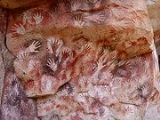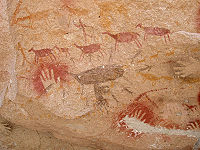
Cueva de las Manos
Encyclopedia
Cueva de las Manos is a cave
or a series of caves located in the province
of Santa Cruz, Argentina
, 163 km (101 mi) south of the town of Perito Moreno
. It is famous (and gets its name) for the painting
s of hand
s, made by the indigenous inhabitants (possibly forefathers of the Tehuelches) some 9,000 years ago. The composition of the ink
s is mineral, and thus cannot be carbon dated
, so the age of the paintings was calculated from the remains of bone-made pipes used for spraying the paint on the wall blocked by the hand.

 The cave lies in the valley of the Pinturas River
The cave lies in the valley of the Pinturas River
, in an isolated spot in the Patagonia
n landscape. It is most easily reached by a gravel road (RP 41), which leaves Ruta 40
3 km north of Bajo Caracoles
and runs 46 km northeast to the south side of the Pinturas Canyon
. The north side of the canyon can also be reached by rough, but shorter, roads from Ruta 40. A 3 km path connects the two sides of the canyon, but there is no road link.
The main cave measures 24 m (79 ft) in depth, with an entrance 15 m (49 ft) wide, and it is initially 10 m (33 ft) high. The ground inside the cave has an upward slope; inside the cave the height is reduced to no more than 2 m (7 ft).
The images of hands are often negative (stencil
led). Besides these there are also depictions of human beings, guanacos, rhea
s, feline
s and other animals, as well as geometric
shapes, zigzag
patterns, representations of the sun
, and hunting
scenes. Similar paintings, though in smaller numbers, can be found in nearby caves. There are also red dots on the ceilings, probably made by submerging their hunting bolas
in ink, and then throwing them up. The colours of the paintings vary from red (made from hematite
) to white, black or yellow. The negative hand impressions are calculated to be dated around 550 BC, the positive impressions from 180 BC, and the hunting drawings to be older than 10,000 years
Most of the hands are left hands, which suggests that painters held the spraying pipe with their dexterous hand.
Cueva de las Manos has been listed as a World Heritage Site
since 1999.
Cave
A cave or cavern is a natural underground space large enough for a human to enter. The term applies to natural cavities some part of which is in total darkness. The word cave also includes smaller spaces like rock shelters, sea caves, and grottos.Speleology is the science of exploration and study...
or a series of caves located in the province
Provinces of Argentina
Argentina is subdivided into twenty-three provinces and one autonomous city...
of Santa Cruz, Argentina
Argentina
Argentina , officially the Argentine Republic , is the second largest country in South America by land area, after Brazil. It is constituted as a federation of 23 provinces and an autonomous city, Buenos Aires...
, 163 km (101 mi) south of the town of Perito Moreno
Perito Moreno, Santa Cruz
Perito Moreno is a town in the northeast of Santa Cruz Province, Argentina, 25 km east of Lake Buenos Aires. It should not be confused with the Perito Moreno National Park over 300 km south by road, or the Perito Moreno Glacier near El Calafate. The town is the capital of the Lago Buenos Aires...
. It is famous (and gets its name) for the painting
Cave painting
Cave paintings are paintings on cave walls and ceilings, and the term is used especially for those dating to prehistoric times. The earliest European cave paintings date to the Aurignacian, some 32,000 years ago. The purpose of the paleolithic cave paintings is not known...
s of hand
Hand
A hand is a prehensile, multi-fingered extremity located at the end of an arm or forelimb of primates such as humans, chimpanzees, monkeys, and lemurs...
s, made by the indigenous inhabitants (possibly forefathers of the Tehuelches) some 9,000 years ago. The composition of the ink
Ink
Ink is a liquid or paste that contains pigments and/or dyes and is used to color a surface to produce an image, text, or design. Ink is used for drawing and/or writing with a pen, brush, or quill...
s is mineral, and thus cannot be carbon dated
Radiocarbon dating
Radiocarbon dating is a radiometric dating method that uses the naturally occurring radioisotope carbon-14 to estimate the age of carbon-bearing materials up to about 58,000 to 62,000 years. Raw, i.e. uncalibrated, radiocarbon ages are usually reported in radiocarbon years "Before Present" ,...
, so the age of the paintings was calculated from the remains of bone-made pipes used for spraying the paint on the wall blocked by the hand.


Pinturas River
The Pinturas River is a river in Patagonia Argentina, running through the Pinturas River Canyon, near the Cueva de las Manos archeological site....
, in an isolated spot in the Patagonia
Patagonia
Patagonia is a region located in Argentina and Chile, integrating the southernmost section of the Andes mountains to the southwest towards the Pacific ocean and from the east of the cordillera to the valleys it follows south through Colorado River towards Carmen de Patagones in the Atlantic Ocean...
n landscape. It is most easily reached by a gravel road (RP 41), which leaves Ruta 40
National Route 40 (Argentina)
National Route 40 or RN40, often called Ruta 40 even in English texts, is a route in western Argentina, stretching from Cabo Virgenes in Santa Cruz Province in the south to La Quiaca in Jujuy Province in the north, running parallel to the Andes mountains...
3 km north of Bajo Caracoles
Bajo Caracoles
Bajo Caracoles is a village and municipality in Santa Cruz Province in southern Argentina. It lies on Ruta 40 some 127 km south of the town of Perito Moreno, and 3 km south of the junction with the access road to Cueva de las Manos....
and runs 46 km northeast to the south side of the Pinturas Canyon
Pinturas River Canyon
The Pinturas River Canyon located 160 km from the town of Perito Moreno in Santa Cruz, Argentina. It is most famous for containing the Cueva de las Manos, ancient cave art dating back some 13,000 years....
. The north side of the canyon can also be reached by rough, but shorter, roads from Ruta 40. A 3 km path connects the two sides of the canyon, but there is no road link.
The main cave measures 24 m (79 ft) in depth, with an entrance 15 m (49 ft) wide, and it is initially 10 m (33 ft) high. The ground inside the cave has an upward slope; inside the cave the height is reduced to no more than 2 m (7 ft).
The images of hands are often negative (stencil
Stencil
A stencil is a thin sheet of material, such as paper, plastic, or metal, with letters or a design cut from it, used to produce the letters or design on an underlying surface by applying pigment through the cut-out holes in the material. The key advantage of a stencil is that it can be reused to...
led). Besides these there are also depictions of human beings, guanacos, rhea
Rhea (bird)
The rheas are ratites in the genus Rhea, native to South America. There are two existing species: the Greater or American Rhea and the Lesser or Darwin's Rhea. The genus name was given in 1752 by Paul Möhring and adopted as the English common name. Möhring's reason for choosing this name, from the...
s, feline
Felidae
Felidae is the biological family of the cats; a member of this family is called a felid. Felids are the strictest carnivores of the thirteen terrestrial families in the order Carnivora, although the three families of marine mammals comprising the superfamily pinnipedia are as carnivorous as the...
s and other animals, as well as geometric
Geometry
Geometry arose as the field of knowledge dealing with spatial relationships. Geometry was one of the two fields of pre-modern mathematics, the other being the study of numbers ....
shapes, zigzag
Zigzag
A zigzag is a pattern made up of small corners at variable angles, though constant within the zigzag, tracing a path between two parallel lines; it can be described as both jagged and fairly regular....
patterns, representations of the sun
Sun
The Sun is the star at the center of the Solar System. It is almost perfectly spherical and consists of hot plasma interwoven with magnetic fields...
, and hunting
Hunting
Hunting is the practice of pursuing any living thing, usually wildlife, for food, recreation, or trade. In present-day use, the term refers to lawful hunting, as distinguished from poaching, which is the killing, trapping or capture of the hunted species contrary to applicable law...
scenes. Similar paintings, though in smaller numbers, can be found in nearby caves. There are also red dots on the ceilings, probably made by submerging their hunting bolas
Bolas
Bolas are a throwing weapon superficially similar to the surujin, made of weights on the ends of interconnected cords, designed to capture animals by entangling their legs...
in ink, and then throwing them up. The colours of the paintings vary from red (made from hematite
Hematite
Hematite, also spelled as haematite, is the mineral form of iron oxide , one of several iron oxides. Hematite crystallizes in the rhombohedral system, and it has the same crystal structure as ilmenite and corundum...
) to white, black or yellow. The negative hand impressions are calculated to be dated around 550 BC, the positive impressions from 180 BC, and the hunting drawings to be older than 10,000 years
Most of the hands are left hands, which suggests that painters held the spraying pipe with their dexterous hand.
Cueva de las Manos has been listed as a World Heritage Site
World Heritage Site
A UNESCO World Heritage Site is a place that is listed by the UNESCO as of special cultural or physical significance...
since 1999.
External links
- Cueva de las Manos in the UNESCO WHC website

